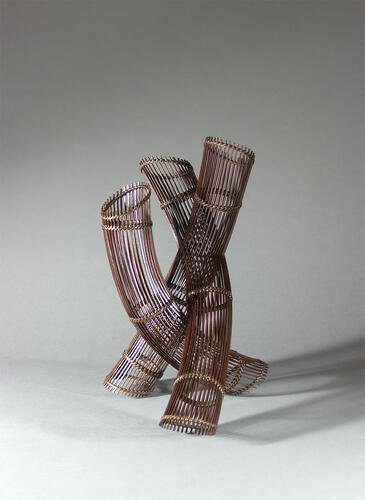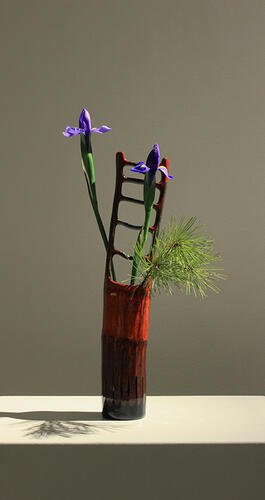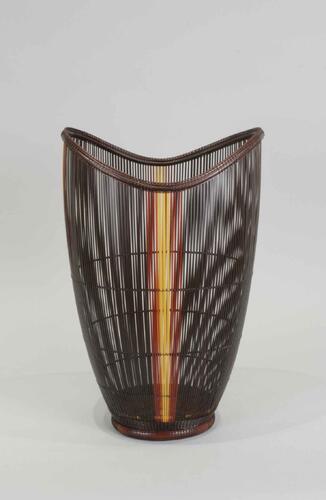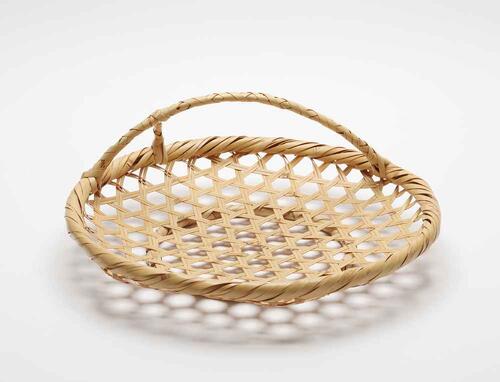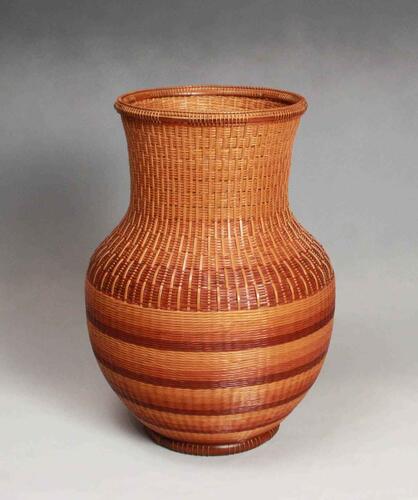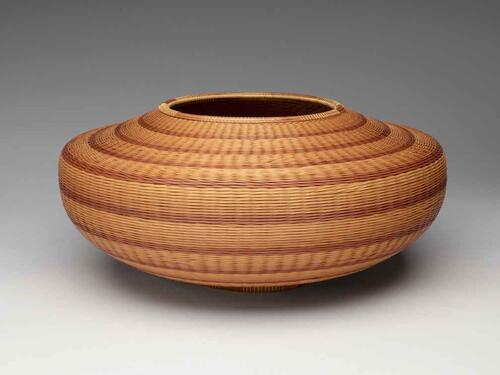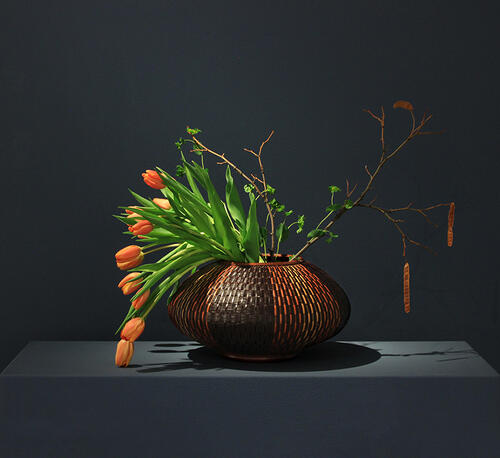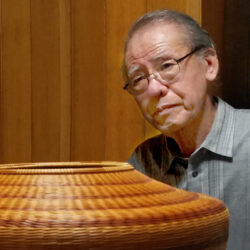
Kajiwara Koho
I was born in Kamitsue, a mountain village of Western Oita. I loved drawing and was very crafty, so a good friend of my aunt who was a village doctor from Oita suggested I go study bamboo craft under Mr. Iwao Kounsai. I went to Oita at the age of seventeen, and spent ten years apprenticed to him. I planned initially to become independent in three or four years, but I changed my mind when I became ill for ten months. I decided to learn from both Kounsai and his son Honan as much as possible.
With the process of bamboo art, it is the preparation of splitting and stripping that is so difficult. Weaving and plaiting alone won’t make a person a “bamboo artist.” Resilience and the beauty of the plaited surface is what I consider the uniqueness of bamboo art.
I feel a part of my brain is constantly thinking about the next work no matter what I am doing. When I get an idea, I draw rough sketches on the back of a calendar and later draw a more detailed plan. I have become quite good at this.
I have tried to express the natural beauty of Japan through bamboo, and I would like to continue doing so. You won’t become rich by being a bamboo artist, but I am happy to see my work give joy to my clients, and my work speaks to who I am as a person.
One of the duties of being a traditional craft artist in Japan is to train one’s successor. Considering, I am lucky for this. I have a few talented individuals whom I have trained step-by-step from beginner to more advanced levels.
Many imports are flooding into the market, and it is not easy to sustain the level of quality. In order to carry on the tradition, we also need to educate consumers that it saves more to buy good quality.
Anyone who is crafty can weave and plait bamboo baskets, but you must have an impressionable heart. If you are type of person who does not think of anything to see a little flower by the street, for example, you should forget about becoming either artisan or artist. When I see many baskets which are no more than a copy of someone else’s work in the exhibitions, I get very disappointed and hurt.
b. 1935, Kamitsue, Oita Prefecture, Japan
-
1952
Apprenticed to Iwao Kounsai and Iwao Honan
Exhibitions & Accolades
-
1965
Admitted to 9th Beppu City Art Exhibition (thereafter admitted many times)
-
1976
Admitted to Oita Prefecture Art Exhibition (thereafter admitted many times)
-
1977
Admitted to Japan Traditional Craft Arts Exhibition, Western Division (thereafter admitted many times)
-
1979
Admitted to Japan Traditional Craft Arts Exhibition (thereafter admitted 14 times and a winner once)
-
1981
First Solo Exhibition at Iwataya
-
1982
Became member of Oita Association of Arts
-
1983
Beppu Municipal Museum acquired his flower basket titled “Aso”
-
1985
Became full member of Traditional Craft Arts Association
Admitted to 2nd Japan Traditional Craft Arts Wood and Bamboo Exhibition -
1986
Official recognition as Traditional Skill Holder
-
1988
Received Beppu Mayor’s Award
-
1991
Winner of NHK Chairman’s Prize at 38th Japan Traditional Craft Arts Exhibition
-
1992
Winner of Full Membership Award at 26th Japan Traditional Craft Arts Exhibition, Western Division
Winner of Governor’s Award and OG Award at 28th Oita Prefecture Art Exhibition -
1993
Received Special Recognition Award from Governor of Oita
-
1996
Prime Minister of Japan presented his work as a gift to the President of France
-
1997
The Beauty of Wood and Bamboo, Iwataya Gallery
-
2003
The Classic Japanese Basket, TAI Gallery, Santa Fe, NM
-
2004
Exhibited in the Hand Workshop Art Center, Richmond, VA
-
2006
Power & Delicacy: Master Works of Japanese Bamboo Art at TAI Gallery, Santa Fe, NM
Hin: The Quiet Beauty of Japanese Art, Grinnell College, IA and Chicago Cultural Center, IL -
2011
Int’l. Fine Art and Antique Dealers Show, New York, NY
-
2013
Oita’s Art Movement, in partnership with the Oita Prefectural Government, a museum-quality show, TAI Gallery, Santa Fe, NM
-
2014
Group show, Japanese American Cultural Community Center, Los Angeles, CA
-
2017
Masterpieces of Japanese Bamboo Art, TAI Modern at Joan B Mirviss LTD, New York, NY
-
2018
Fendre L’ Air, Musee du Quai Branly Jacques Chirac, Paris
-
2021
Ten Thousand Flowers, TAI Modern, Santa Fe, NM
Museum Collections
-
Metropolitan Museum of Art, New York, NY
Imperial Household, Japan
Beppu City Museum of Art
Beppu City Traditional Bamboo Craft Art Museum
Oita Prefectural Art Hall
Philadelphia Museum of Art, PA
I was born in Kamitsue, a mountain village of Western Oita. I loved drawing and was very crafty, so a good friend of my aunt who was a village doctor from Oita suggested I go study bamboo craft under Mr. Iwao Kounsai. I went to Oita at the age of seventeen, and spent ten years apprenticed to him. I planned initially to become independent in three or four years, but I changed my mind when I became ill for ten months. I decided to learn from both Kounsai and his son Honan as much as possible.
With the process of bamboo art, it is the preparation of splitting and stripping that is so difficult. Weaving and plaiting alone won’t make a person a “bamboo artist.” Resilience and the beauty of the plaited surface is what I consider the uniqueness of bamboo art.
I feel a part of my brain is constantly thinking about the next work no matter what I am doing. When I get an idea, I draw rough sketches on the back of a calendar and later draw a more detailed plan. I have become quite good at this.
I have tried to express the natural beauty of Japan through bamboo, and I would like to continue doing so. You won’t become rich by being a bamboo artist, but I am happy to see my work give joy to my clients, and my work speaks to who I am as a person.
One of the duties of being a traditional craft artist in Japan is to train one’s successor. Considering, I am lucky for this. I have a few talented individuals whom I have trained step-by-step from beginner to more advanced levels.
Many imports are flooding into the market, and it is not easy to sustain the level of quality. In order to carry on the tradition, we also need to educate consumers that it saves more to buy good quality.
Anyone who is crafty can weave and plait bamboo baskets, but you must have an impressionable heart. If you are type of person who does not think of anything to see a little flower by the street, for example, you should forget about becoming either artisan or artist. When I see many baskets which are no more than a copy of someone else’s work in the exhibitions, I get very disappointed and hurt.

